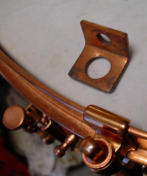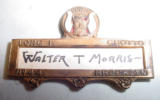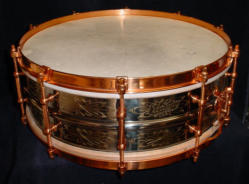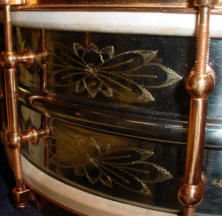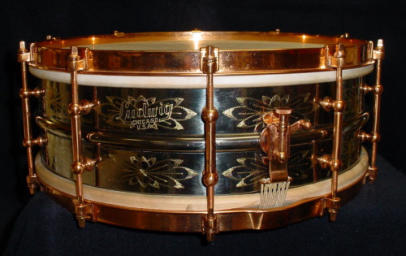



Collector’s Showcase: Mike Curotto
Jim Messina’s Vintage Drums Talk.com


Click on any photo for a larger version.
1923- Ludwig & Ludwig White Enamel 4 x 14 All Metal Dance Model (cat. #5)
Curotto Collection - Page 9

The best way to communicate with Jim is via E-mail to: savoldi1@aol.com
Curotto Collection

Hi all,
Happy Holidays! I was able to belt this one out in between Xmas festivities.
I got this snare drum a few years ago from my good friend and fellow collector Rich Kalinski. It has been in my restoration
queue since so it’s time to clean, restore and present.
A special thanks goes to vintage drum historian Harry Cangany for his assistance as to the date of this drum.
1926-27 LEEDY 4 x 14 COLONIAL GOLD “FULL DRESS” PROFESSIONAL MODEL (Cat. No. 700G)
A little history, learning experience and a thought:
1. The 1927 Leedy Catalog “O” states that: “Colonial Gold is also a Duco finish. It will not chip or crack and will withstand
an unbelievable amount of rough usage. The finish was first introduced in a special outfit of Leedy Drums made for Geo.
W. Marsh , Drummer of the Paul Whiteman Orchestra.” So it looks like The Dupont Company had this finish in their
catalog or possibly created this finish for Leedy.
2. Again from Catalog “O”: “Contrasting shades of gold always create a beautiful effect---so, here we have blended a
satin and a bright Nobby Gold finish that attracts and holds the eye like magic. Drums such as these cannot fail to help
you progress. ‘Full Dress’ finish Drums are not a fad---they are here to stay.” Once again I learned something new ; I
always thought that “Full Dress” meant the diamond shaped (and other shapes) pearls and sparkles that were applied to
the factory finish on a shell.
3. Harry Cangany suggested that maybe Colonial Gold was Leedy’s answer to Ludwig & Ludwig’s All Gold Model...?
THE SHELL:
As advertised, the 4 x 14 shell is in very good shape with no chips or cracks in the finish. All that was needed was a shot
of Simple Green that cleaned off the surface dirt. The Colonial Gold finish had a nice 90 + year old patina so I left it alone.
THE HARDWARE:
All of the hardware is original and in very good condition. The Nobby Gold finish is all there but the years of wear has
added a patina that I decided to leave as-is because it is consistent with the shell. All that I did was clean the hardware
with Simple Green. There was a broken rivet on the Speedway strainer that was easily fixed by my machinist/welder Abe
Abello. I say this every time but it’s worth repeating...Abe is worth his weight in gold, he has brought back to life many
mangled original parts for me, he adds to the enjoyment of my hobby. An added bonus was that all 8 of the 4-screw lugs
were completely crack free...dear diary!
Of-the-era calf heads and Snappi Snares rounded out this cleaning/restoration.
Enjoy!
Mike Curotto
1926-27 Ludwig & Ludwig 6.5 x 14 DeLUXE Stipelgold
Super-Ludwig Model
1926-27 Leedy 4 x 14 Colonial Gold “Full Dress” Professional Model
(Cat. No. 700G)
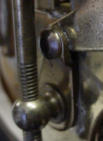
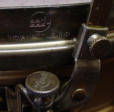
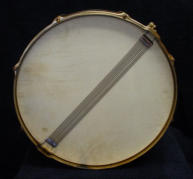
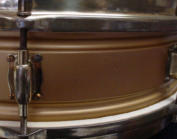
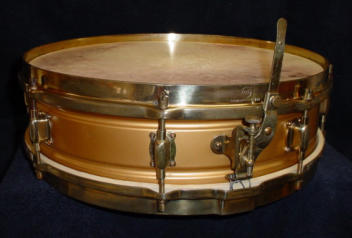
Hi all,
This drumset was first offered to me by Steve Maxwell in 2011. Steve was brokering the drumset for the original owner’s
widow. The timing wasn’t right so I passed even though that snare drum was crying out to me: “Come to Papa...Come to
Papa!”. Steve eventually sold it to a collector named Mike Leshkevich. I know Mike and I know that the drumset went to a
good home/collection. Fast forward to Feb. 2017, I got a call from my good friend and fellow collector Tony Lewis who
informed that Mike was now ready to sell the drumset and that he (Tony) had recommended me as a possible buyer. Mike
contacted me and a very fair deal was made.
1940 LEEDY 7 x 14 BROADWAY STANDARD “SWINGSTER” MODEL #624 (SPECIAL ORDER/ONE-OFF MARINE
PEARL/AUTOGRAPHS of the STARS)
1940 LEEDY “THE IMPROVED” NEW YORKER OUTFIT #5380 (SPECIAL ORDER/ONE-OFF MARINE
PEARL/AUTOGRAPHS of the STARS)
I am not a drumset collector but when this drumset was offered to me -- a second time -- I went for it. I usually don’t buy
snare drums as an investment, I love to collect them so if they are worth more money in the future that’s a good thing but if
the value stays the same or goes down I honestly don’t care as it has always been more important to me to own the snare
for the collection rather than worry if the drum will eventually be worth more money. This drumset was purchased as an
investment, especially since the snare drum alone is worth as much as I paid for the entire drumset. Don’t misinterpret this, I
paid Mike’s asking price and he was happy with our deal.
Special thanks goes to Steve Maxwell for allowing me to use his video clip of the drumset...
https://www.youtube.com/watch?v=Qvi5ENIoHlk and his website article about this drumset:
http://www.maxwelldrums.com/leedy-autograph-stars-complete-unique-p-5727.html
The Maxwell Drums video and website text says it all so be sure to check those out as they are very informative.
Another special thanks goes to Tony Lewis for recommending me to Mike, for brokering the deal AND for shipping these
drums to me.
I did clean up the Leedy 7 x 14 Broadway Standard “Swingster” so I have included a few photos because... after all of the
dust settles... I am still a snare drum type-of-guy.
My wife puts up with my 625 + snare drums in our home so one little, rare, one-of-a-kind, special order, one-off drumset
shouldn’t make a difference, right?
As always, feel free to weigh-in with your comments and stories.
Enjoy!
Mike Curotto
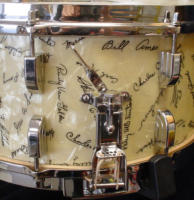
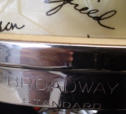
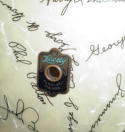

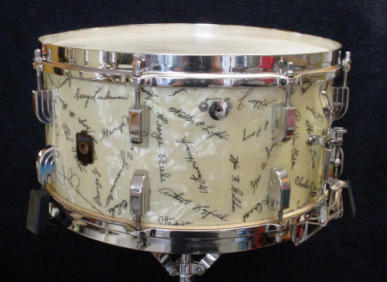
1940 Leedy 7 x 14 Broadway Standard “SWINGSTER” Model #624 (Special
Order/One-Off Marine Pearl/Autographs of the Stars)

Hi all,
I got this snare drum from a dealer in Japan. Tetsuya made me a fair deal so I jumped at the chance to fill a gap in my
collection.
1926-27 LUDWIG & LUDWIG 6.5 x 14 DeLUXE STIPELGOLD SUPER-LUDWIG MODEL
A LITTLE HISTORY:
Ludwig introduced the new Stipelgold finish in their 1926 catalog. “The New Ludwig “STIPELGOLD” finish is a special
composition producing a marvelous *“Stippled” effect in a bright golden hue. It is hard and durable, adhering tenaciously to
the shell of metal or of wood.” The 1927 catalog introduces the “New Ludwigold Iridescent Display Finish”. It looks like the
Stipelgold finish was short-lived, maybe 1-2 years. Aside from the 1926 catalog, the only other reference to the Stipelgold
finish is at the bottom of the first page of the 1927 catalog: “LUDWIGOLD or STIPELGOLD at the same price.” So as best
as I can tell by researching the 1926, 1927 catalogs and Rob Cook’s DRUM COLORS THE REBEATS COLOR SWATCH
BOOK; Stipelgold was only around for one year, 1926.
*stipple- noun, Also, stippling
2. the method of painting, engraving, etc., by stippling.
3. stippled work; a painting, engraving, or the like, executed by meansof dots or small spots.
v. 1670s, from Dutch stippelen "to make points," frequentative of stippen "toprick, speckle," from stip "a point," probably
ultimately from PIE root*st(e)ig- "pointed"
THE SHELL:
The Stipelgold finish on this drum shell shows the normal age/patina/gunk/schmutz but the finish covers the vast majority of
the shell. Although Ludwig states: “It is hard and durable, adhering tenaciously to the shell of metal or of wood etc...” I have
seen and own a couple of Stipelgold drums that have a few “divots” in the shell. This 90 + year old snare drum shell has a
few small “divots” but is well preserved. I was able to get a layer or two of schmutz off of the shell using some Oxy-Clean
foaming cleaner, it did freshen up the shell a little.
THE HARDWARE:
The DeLuxe plated hardware had a lot of tarnish on the brass parts and some rust on the steel parts where the original
factory lacquer had worn off. I was able to save the original copper plating so everything cleaned and polished up nicely.
All of the hardware is original, nothing was missing. The Super mechanism works perfectly. The drum came with original
snares that were pretty thrashed but I had a set of Super snares in my stash. The top and bottom calf heads are of-the-era.
FINAL THOUGHTS:
Those of you who know me are well aware of the fact that I like to collect “sets” of snare drums, e.g. 4 x 14, 5 x 14 and 6.5
x 14 etc. I own a 4 x 14 and a 5 x 14 Stipelgold Super-Ludwig so when the opportunity came along to complete the set I
went for it. It seems that 10-lug, 6.5 x 14 2-piece heavy brass snare drums from this era (1925-29) are pretty rare. I also
added a photo of the completed set of Stipelgold Super-Ludwigs.
As always, I welcome your comments, stories and photos
Enjoy!
Mike Curotto

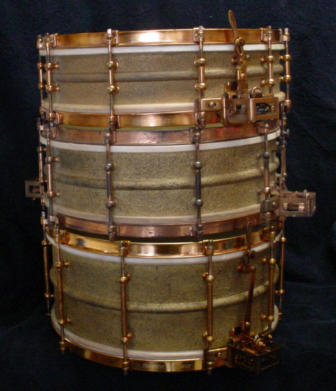
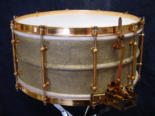
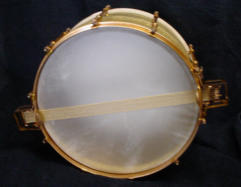
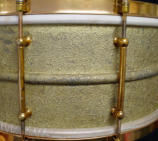
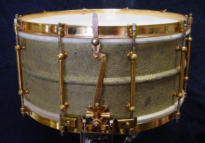
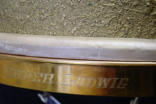
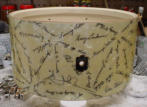
Hi all,
I just got this one a few days ago. My good friend and local drum collector Jimmy Sisson found this gem of a drum in a
little “Ma & Pa” store in San Jose, CA. Jimmy called me and wanted to show me his new find so I said “come on by”.
After seeing the drum and complimenting him on his new acquisition I went into my drum collector mode and I asked
him if he wanted to sell the drum to me. Although Jimmy really wanted me to see the drum he also knew that I would
want to buy it...he was right! We made a great deal and here we are. This is a good ending for everyone; the store
owner got the drum for a low price, Jimmy got it for a great price and I was able to double his money plus 200.00.
1930 LEEDY 5 x 14 NOBBY GOLD “THUNDERBIRD PATTERN” BLACK ELITE “FULL DRESS” MODEL (Cat.
#2720)
A special thanks goes to my friend Bill Wanser for helping me to pinpoint a date of 1930 as per Leedy Catalog “S”.
THE DRUM:
This snare drum is one of the cleanest Nobby Gold Black Elites that I have ever seen or owned. This drum was so
clean that all I had to do was wipe the shell and the hardware with a soft cloth. I did clean out the tension rod threads
but that was it. I added an of-the-era Leedy HardWhite batter head and Leedy slunk head. The drum came with a set
of James Snappi-wires on the Parallel mechanism side but I chose to use original wire wound snares (a real pain in
the ass to attach by the way). Although Leedy Broadway Duals and Ludwig & Ludwig Super-Sensitives were most
likely built right across the way from each other I have seen that both internal linkages were usually the same but here
there is a slight difference in the Leedy internal Dual mechanism (linkage) vs. the L & L Sensitive internal mechanism
(linkage).
This was an easy one.
Enjoy!
Mike Curotto
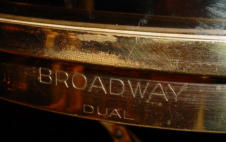
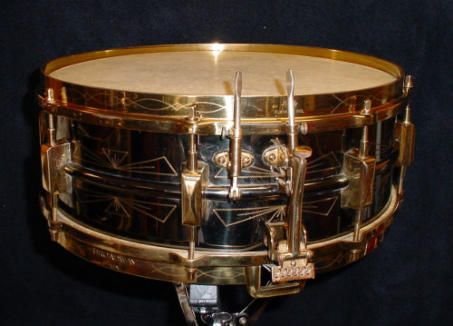
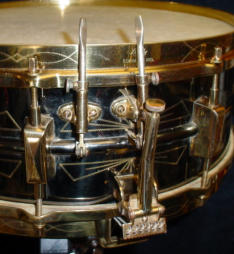
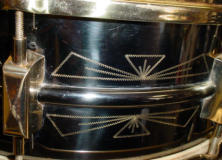
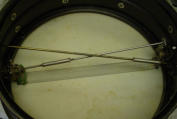
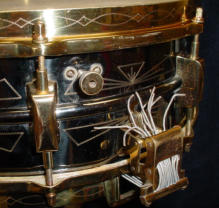
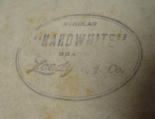
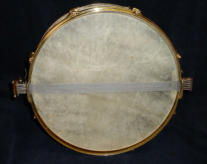
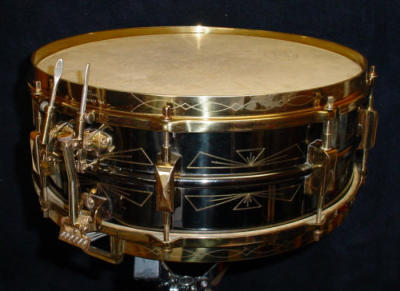
1930 Leedy 5 x 14 Nobby Gold “Thunderbird Pattern” Black Elite
“Full Dress” Model (Cat. #2720)


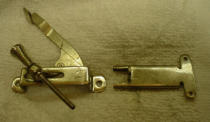
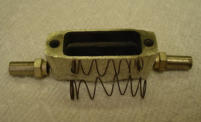
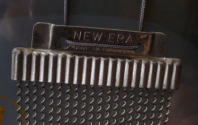
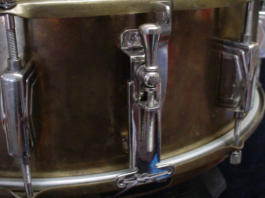
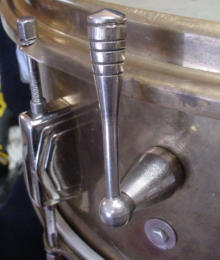
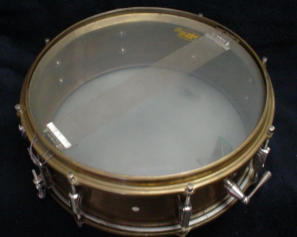
1970s 5 x 14 POLMUZ BRASS/NICKEL PROTOTYPE “IRON CURTAIN” SNARE
DRUM
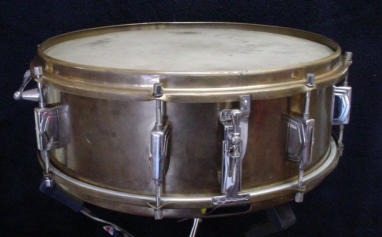
Hi all,
My newest snare drum is a bit of a quirky one from 1970s Poland (Iron Curtain era). I got this drum from a European
collector named Marek Piotrowski.
This drum has an interesting vibe/mojo to it in that it was produced in Poland by the Polmuz Musical Instrument Company,
a government owned musical instruments manufacturer.
1970s 5 x 14 POLMUZ BRASS/NICKEL PROTOTYPE “IRON CURTAIN” SNARE DRUM
Here’s what Marek had to say about this drum:
“I have an interesting snare drum: it is 5" x 14" bare brass shell and hoops. It was made in 1970's in Poland by Polmuz -
government owned musical instruments manufacturer. Best to my knowledge it is a prototype drum. I got it from a guy who
used work for Polmuz as a brass wind instruments maker. He acquired it when they were closing in 1990's. As you can
see the lugs look similar to Ludwig Imperial lugs. Hoops look like a copy of Slingerland hoops. I've never seen a drum like
this before - being a user of Polmuz in 1970 myself. No Polmuz stamp/markings on the drum - that again makes me think
it was a prototype drum. The condition is very good. It still has original Ever Play /Premier/ made in England heads and
New Era made in England wires. Polmuz was working with Premier back than. Let me know if a piece of rock hardware
from behind the Iron Curtain will be of interest to you. The full name of the company is Polmuz Warsaw Wind and
Percussion Instruments Factory founded 1953 Made in Poland.
Best regards,
Marek Piotrowski”
I also consulted with my good friend Emmanuel of olDrums Vintage & Custom.
Here’s what Emmanuel had to say about this drum:
“I don't know very well this brand, probably a confidential and rare production because it was behind the "iron curtain"...
After some research on the net, I did not find this snare drum model... Find some Polmuz wood snare, some Polmuz metal
snare but no Polmuz brass snare... And without badge, it's maybe really a prototype... then very rare ! ! Good deal ;)
A bientôt,
Emmanuel
olDrums Vintage & Custom
http://www.oldrums.fr/”
THE SHELL:
The 5 x 14 heavy brass shell looks raw and “prototype-ish”. The bearing edges are “rolled” over but not tucked back and
soldered as we would see on an American heavy brass shell drum. I wanted to keep the “Iron Curtain” mojo intact so I left
the shell as is and just cleaned it with Simple Green and a light coat of lemon oil. There is no badge or manufacturer’s
marking on the shell but there is an “air hole/vent” just left of the strainer that may have been drilled for a badge but at this
time I’ll just call it an “air hole/vent”.
THE HARDWARE:
A few interesting things here with the hardware. First off is the nickel plated hardware that you normally would not see on a
1970s drum, maybe that was how they did things in Communist Poland in the 1970s. The 8 hole top and bottom triple
flange rims are raw brass and in the style of Slingerland’s Stick Saver rims. The tension rods are nickel plated with hex
heads similar to what you would see on a 1930s Leedy & Strupe snare drum. The 8 nickel plated lugs are of a style similar
to Ludwig’s Imperial lugs with the slight difference being that the inserts are not flush with the lug casings. The nickel
plated strainer and butt plate resemble a crude Ludwig P-83 and generic Ludwig butt plate . The nickel plated tone control
has green felt and resembles a 1960s Ludwig Base Ball Bat tone control but with a much bigger “bat”. All of the
attachment screws and nuts are metric. I left the rims alone as I did with the shell but I did clean and polish all of the nickel
plated parts.
As Marek mentioned above Polmuz was working with Premier at the time so I used the Premier Ever Play heads and
Premier 20 strand New Era snares that came with the drum.
FINAL THOUGHTS:
I like quirky, unusual snare drums. While this drum would not be considered a high end drum it certainly has an interesting
vibe/mojo to it that attracted my interest. It’s an Iron Curtain artifact from a very troubled time in the world.
Enjoy!
Mike Curotto
STORY #1:
The old saying “the sun shines on a dog’s butt at least once a day” definitely applies here. I had just been collecting for
over a year when this snare drum came my way. I noticed right away that it was an 8 lug, 2-pc., heavy brass shell All
Metal Dance Model. I also noticed the white enamel paint on the shell and rims but that did not stop me from
purchasing the drum as I was totally confident that I could strip the white enamel and clean that puppy up nicely. Here’s
where a little karmic luck entered into my early vintage snare drum collecting hobby. Just before I was going to start
stripping the white enamel off of the shell and rims a new VHS tape (remember, 1996) featuring legendary Jazz
drummers came out; the first drummer that was featured on that video was Warren “Baby” Dodds who is seen playing a
5 x 14, 8 lug, white enamel version of the drum I had recently purchased. All together now: “step away from the enamel
stripper neophyte vintage snare drum collector Mike Curotto”. Needless to say my drum collecting karma was in the
plus-column that day.
STORY #2:
The top and bottom calf heads that came with the drum look to be of-the-era. An interesting artifact from yesteryear is
on the top head where there are twelve names that are written in very elegant 1920s style script, most likely fellow
band members of The White Eagle Orchestra from a long ago great era. I wonder if “Connie” was the drummer given
that his/her name is prominently placed on the head and did “M. Filipek“ do a good job of managing the orchestra?
Who, what, when and where...? I love dwelling on stuff like this.
THE SHELL:
The 4 x 14, 2-pc. heavy brass shell is structurally sound with no major dents or extra holes but the white enamel
definitely shows its age both on the shell and the rims. I lightly cleaned the white enamel and was happy to leave the 93
+ year old mojo alone. The Ludwig stamp is clearly visible under the white enamel in the same panel as the P-338
strainer. The factory air vent is in the upper half of the panel just left of the strainer; I mention this because I have also
seen factory air vents on 8 lug All Metal Models in the upper half of the panel just left of the butt plate.
THE HARDWARE:
The hardware was all there and the nickel plating cleaned and polished up nicely. .
Of-the-era gut snares rounded out the cleaning of this snare drum.
I always welcome your comments and related stories.
Enjoy!
Mike “Lucky” Curotto
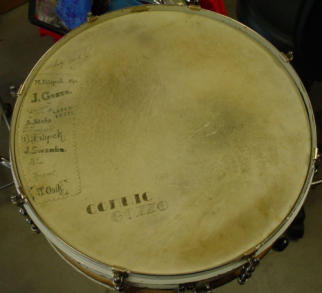
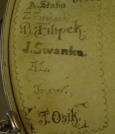
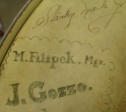

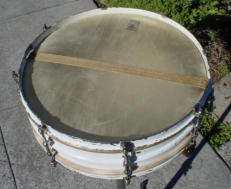
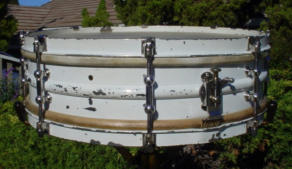
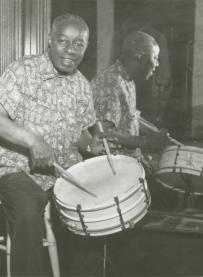

Hi all,
While I am in between purchases I thought that I would write about another snare drum that I purchased before I started
to write articles. This snare drum can been seen on pages 18 & 19 in my book: VINTAGE SNARE DRUMS THE
CUROTTO COLLECTION VOL. I
1926-27 LUDWIG & LUDWIG 5 x 14 10 LUG 12 PT. FLORAL ENGRAVED DeLUXE ALL-AROUND MODEL (cat.
no. 1)
This drum was on EBay about 13-15 years ago. It was an early morning (1 am) ending auction so I waited up for it and
sniped it right at the end. The drum was found in a closet at the Long Island Grotto #44 Masonic Lodge in Brooklyn, New
York. There was a name pin that came with the drum so I googled Walter T. Morris, Long Island Grotto #44 and made
some phone calls but no one was interested in helping me with the history of Walter T. Morris so I’m just reporting what I
have in front of me. This drum looks virtually unused but I suspect that this drum was used in some type of ceremony or
used in marching as there was a matching “L” hook that enabled Mr. Morris or any other drummer to use a shoulder
strap sling for marching. Man I would have loved to have been a fly on the wall during those Masonic Lodge ceremonies
and meeting.
This DeLuxe is definitely the cleanest example of any of my Black Beauties, some are close but this one is the real deal.
Noted Black Beauty expert John Aldridge told me that he believes my drum is the best example of a mint/near-mint
1920s DeLuxe (Black Beauty) that he has ever seen.
As always, I welcome your thoughts and related stories.
Enjoy!
Mike Curotto
1926-27 Ludwig & Ludwig 5 x 14 10 Lug 12 PT. Floral Engraved DeLuxe
All-Around Model (cat. no. 1)
